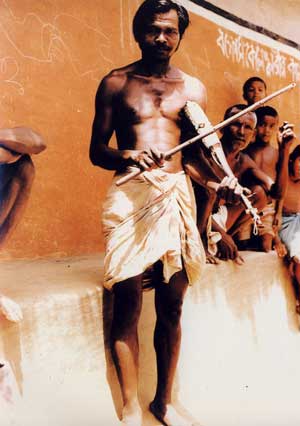
|
The banam is a class of folk fiddles found among the Santal
people of North East India and Bangladesh. Classification of the various forms of banam are difficult. Among the Santalis, Tendor Banam, Dhodro Banam, Huka Banam and a host of other names may be applied to them. However the Santalis tend to, classify their instruments according to ornamentation rather than structural elements. Furthermore there is extreme variety because each instrument reflects the artistic vision of its maker.
The banam is very import to the Santal people. According to legend, at one time there were seven brothers who conspired to kill and eat their sister. But the youngest brother was so overcome by guilt that he could not bring himself to eat his portion. He surreptitiously buried it in an ant hill. Upon that spot, a beautiful tree grew. A stranger passing the tree, hears a beautiful sound emanating from it. He cuts a branch off the tree and fashions the first banam.
The importance of the banam to the Santals is well represented by the artwork on the instruments. In many cases the major portion of the work goes into these elaborate carvings. Human figures are an especially important motif. It is interesting to note that some of the most elaborately carved banams may be the crudest from a purely musical standpoint. Many times they may have only a single string and in some case are not even fitted with a tuning peg.
The number of strings varies. A single string is the most common,
but two, three, and even four strings are to be found. |
||